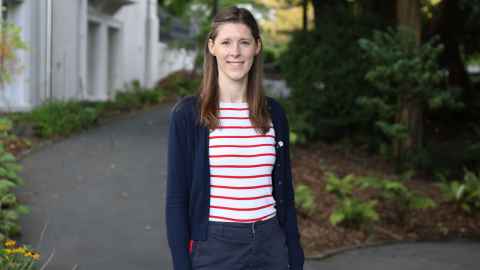Take 10 with... Rosalyn Falconer
Dr Rosalyn Falconer, from the School of Chemical Sciences, gives us 10 minutes of her time to discuss her research on synthesising, and better controlling, catalysts featuring earth abundant metals.

1. Describe your research topic to us in 10 words or less.
Making sustainable catalysts using surface organometallic chemistry.
2. Now explain it in everyday terms!
Catalysts lower the energy needed for chemical reactions to happen, without being used up themselves. They do this by lowering the temperature or pressure required, increasing selectivity of the products we want, or decreasing byproducts and waste. Over 90% of industrial chemical processes use catalysts to make them cheaper to run. However, the best catalysts often use precious metals that are expensive and rare, so mining them has a high environmental cost.
I am interested in finding more sustainable catalysts by using metals that are more abundant in the Earth’s crust, such as titanium or aluminium. These metals are often more difficult to use as their reactivity is more challenging to predict and control. In my lab, we make new catalysts, and test their reactivity and ability to catalyse reactions. We use many techniques to achieve this, such as studying catalysts that are dissolved in solutions and ones that are attached to solids. This research crosses the boundaries of organic, inorganic and materials chemistry.
3. Describe some of your day-to-day research activities.
Meeting with students to discuss experiments and results, training students to use equipment in the lab, reading the literature to come up with new ideas, writing grant proposals and papers.
4. What do you enjoy most about your research?
Trying to solve the puzzle! Research is full of questions and I love finding the answers. These can be anything from day-to-day problems (how do I filter this mixture whilst avoiding contact with air?) to bigger questions like how can we make this catalyst more selective?
5. Tell us something that has surprised you in the course of your research.
Interesting colours are always a welcome surprise in chemistry! For one series of reactions, I kept intermittently seeing a really intense purple colour. Sometimes it would last seconds, other times it would persist for a few hours. It took me over six months to optimise the synthesis and reliably make the chemical that was responsible. It turned out to have a really interesting Al=Al (double) bond, which gave it the intense colour but also made it very reactive with air, water or anything else.
6. How have you approached any challenges you’ve faced in your research?
I try to take a step back and look at it from a different angle. This could be by reading the literature or discussing it with colleagues. When I’m really stuck, I take some time away from it to focus on another project, or do something else. I often solve problems when I’m at the gym or cooking dinner!
7. What questions have emerged as a result?
An important one is how can we make the scientific advances discovered in universities more useful to society. Many discoveries are reported every day in academic journals, but very few are transferred to be used in industrial processes. We need to find a way to use this knowledge.
8. What kind of impact do you hope your research will have?
I hope some of the catalysts we discover will be adopted in industrial chemical production to either decrease its environmental impact or increase the range of chemicals that can be produced on an industrial scale. I also hope that we can build rules to understand the chemistry of earth-abundant metals so that they can be used more widely to improve the sustainability of chemistry.
9. If you collaborate across the faculty or University, or even outside the University, who do you work with and how does it benefit your research?
Since I joined the University of Auckland in 2024, I have started some new collaborations with other academics in the School of Chemical Sciences, including Prof David Barker and Associate Professor Erin Leitao. I also have some collaborators from other countries including Canada (Prof Laurel Schafer, University of British Columbia) and France (Dr. Chloé Thieuleux and Dr. Clément Camp, CNRS). I have an ongoing collaboration with Dr. Tobias Krämer at Trinity College Dublin, who performs calculations to help us understand experimental results.
I am always looking for new collaborators, from industry or academia – please get in touch if you are interested in working together.
10. What one piece of advice would you give your younger, less experienced research self?
Resilience comes with time. Be kind to yourself when rejections happen and celebrate all the successes along the way.